Abstract
Recombinant wild-type and mutated forms of human complement component C9 have been synthesized in baculovirus-infected insect cells. Wild-type recombinant C9 was indistinguishable from native C9, as judged by haemolytic activity, trypsin and alpha-thrombin digestion, reaction with antibodies to C9, enzymatic deglycosylation to the same core size and polymerization in the presence of Zn2+. Replacement of the native signal peptide with the honey-bee melittin signal peptide, and replacement of Spodoptera frugiperda (Sf9) cells with Trichoplusia ni cells produced yields of 5 micrograms C9/ml supernatant. Three C9 mutants were generated; one mutant, with four acidic residues changed to alanines in a putative calcium-binding site, had the same biological activity as recombinant C9. Another mutant, lacking 23 N-terminal amino acids, previously showing increased polymerization when produced in vitro, polymerized on secretion, rendering it inactive. It was not possible to demonstrate haemolytic activity of the third mutant, cysteines 33 and 36 mutated to alanine, as it was secreted a hundredfold less than the wild-type protein.
Full text
PDF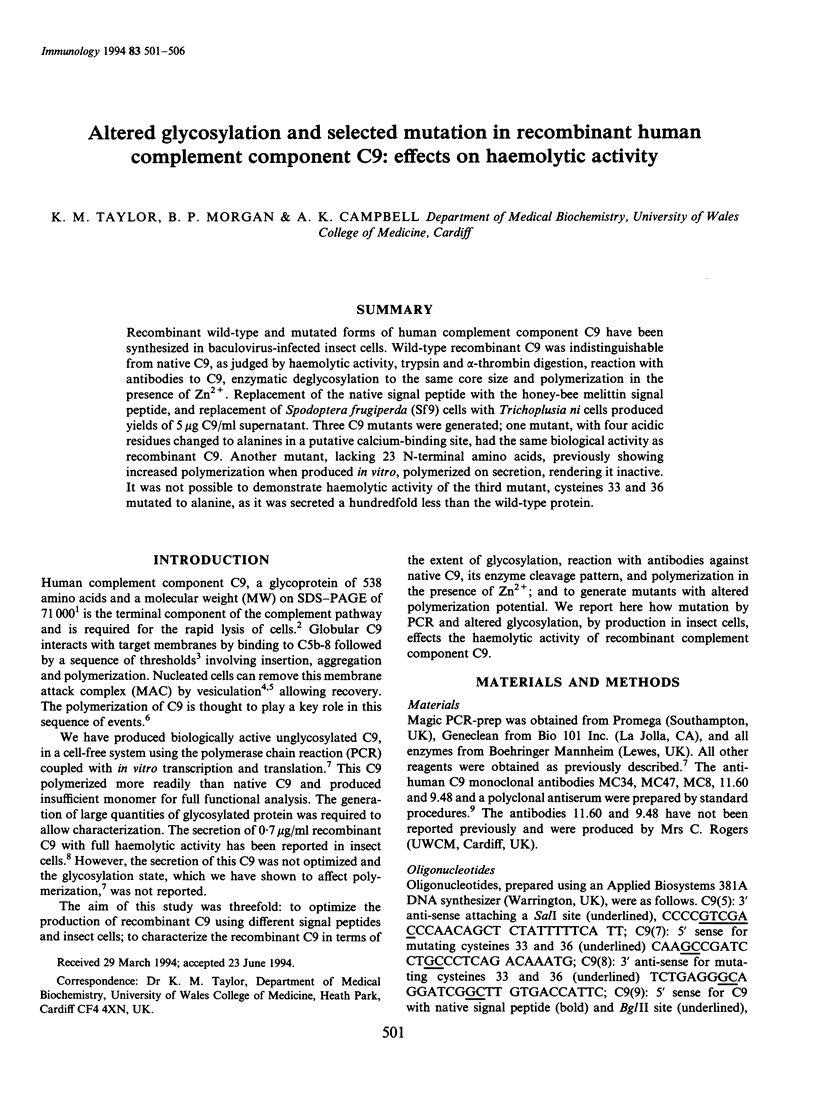
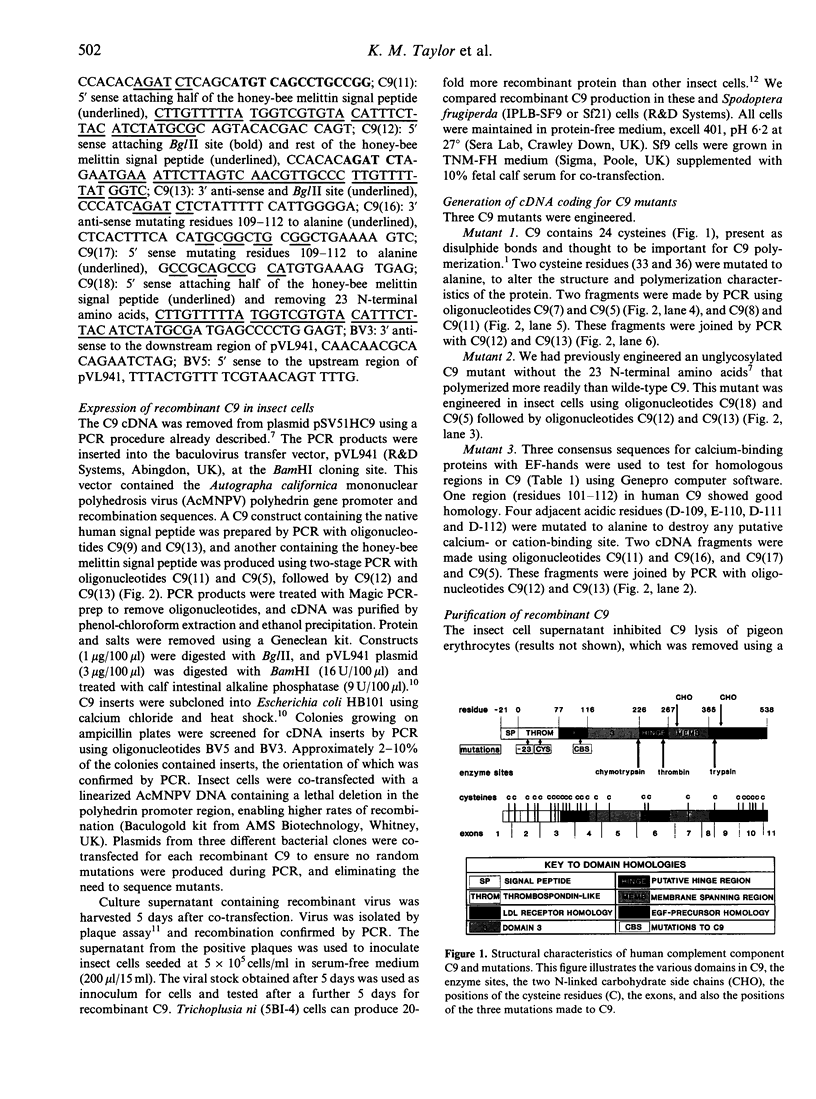
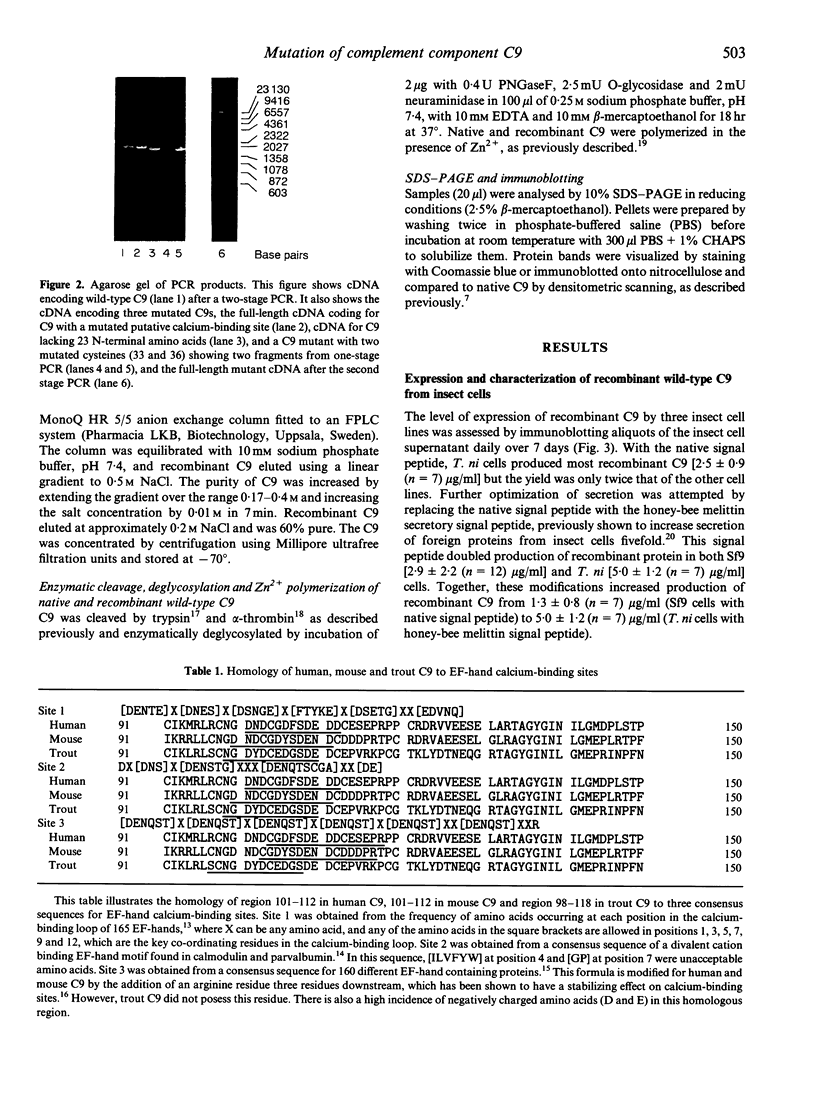
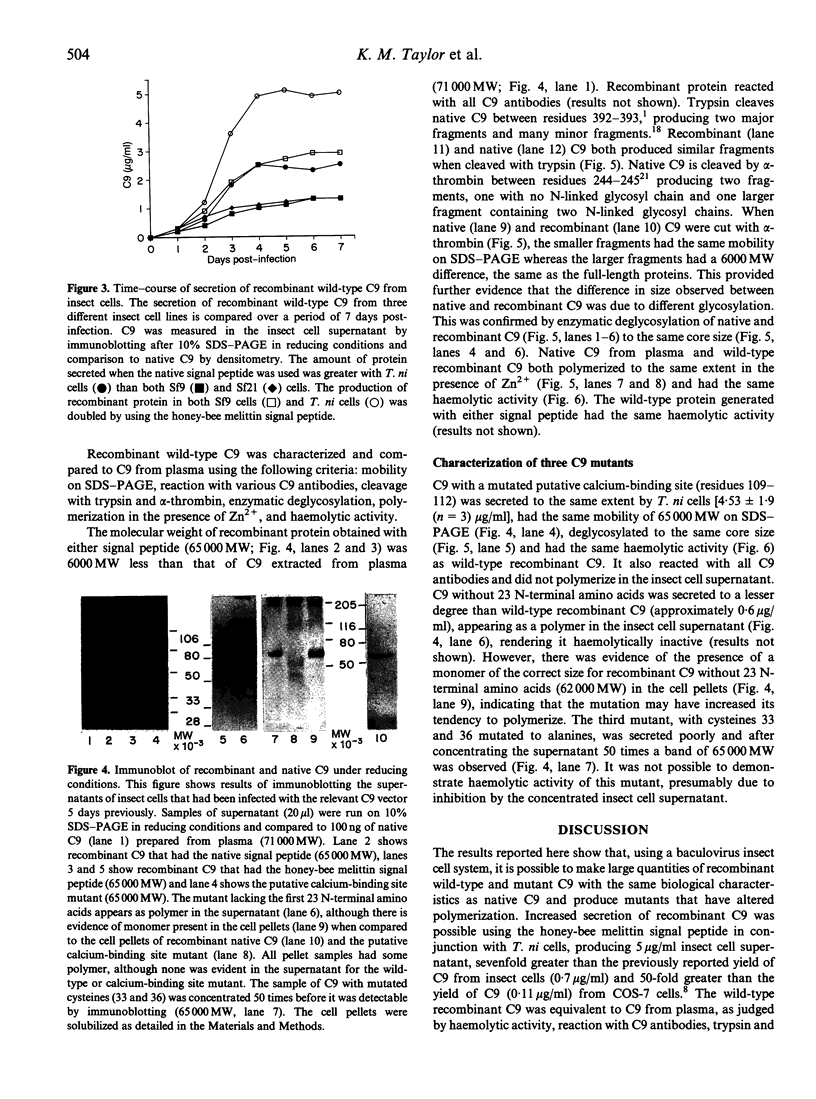

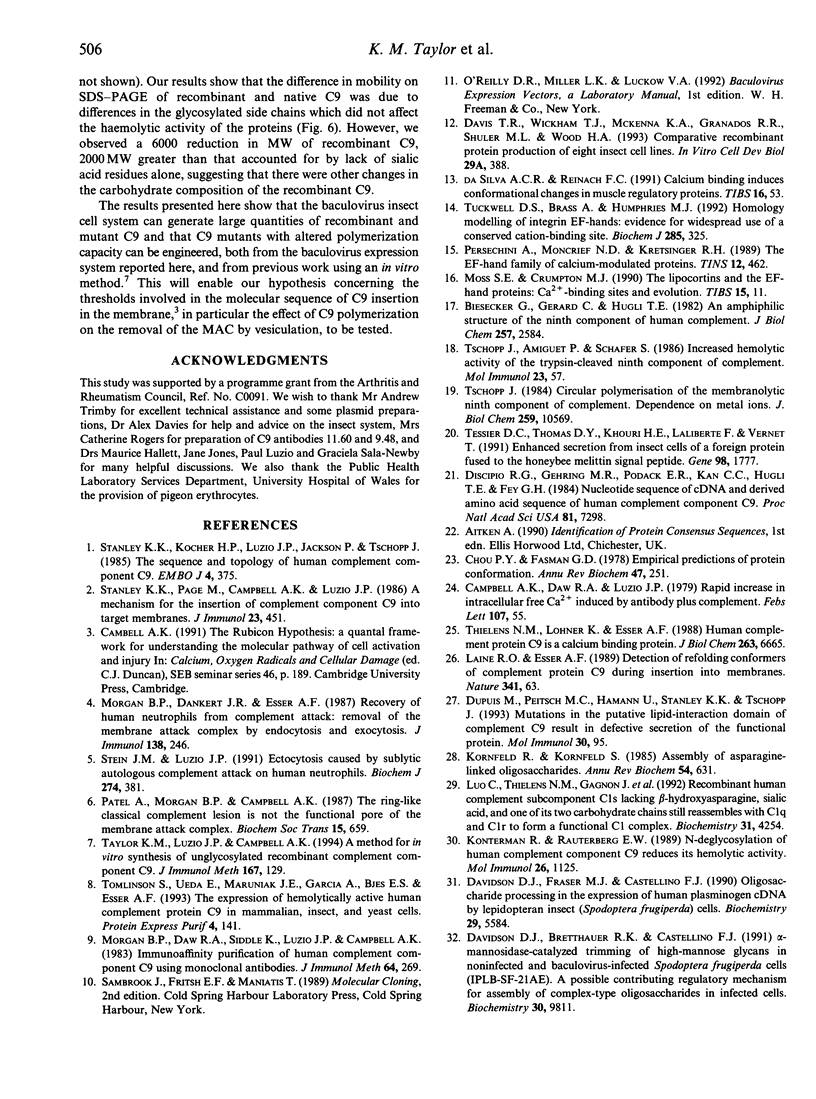
Images in this article
Selected References
These references are in PubMed. This may not be the complete list of references from this article.
- Biesecker G., Gerard C., Hugli T. E. An amphiphilic structure of the ninth component of human complement. Evidence from analysis of fragments produced by alpha-thrombin. J Biol Chem. 1982 Mar 10;257(5):2584–2590. [PubMed] [Google Scholar]
- Chou P. Y., Fasman G. D. Empirical predictions of protein conformation. Annu Rev Biochem. 1978;47:251–276. doi: 10.1146/annurev.bi.47.070178.001343. [DOI] [PubMed] [Google Scholar]
- Davidson D. J., Bretthauer R. K., Castellino F. J. alpha-Mannosidase-catalyzed trimming of high-mannose glycans in noninfected and baculovirus-infected Spodoptera frugiperda cells (IPLB-SF-21AE). A possible contributing regulatory mechanism for assembly of complex-type oligosaccharides in infected cells. Biochemistry. 1991 Oct 15;30(41):9811–9815. doi: 10.1021/bi00105a001. [DOI] [PubMed] [Google Scholar]
- Davidson D. J., Fraser M. J., Castellino F. J. Oligosaccharide processing in the expression of human plasminogen cDNA by lepidopteran insect (Spodoptera frugiperda) cells. Biochemistry. 1990 Jun 12;29(23):5584–5590. doi: 10.1021/bi00475a024. [DOI] [PubMed] [Google Scholar]
- Davis T. R., Wickham T. J., McKenna K. A., Granados R. R., Shuler M. L., Wood H. A. Comparative recombinant protein production of eight insect cell lines. In Vitro Cell Dev Biol Anim. 1993 May;29A(5):388–390. doi: 10.1007/BF02633986. [DOI] [PubMed] [Google Scholar]
- DiScipio R. G., Gehring M. R., Podack E. R., Kan C. C., Hugli T. E., Fey G. H. Nucleotide sequence of cDNA and derived amino acid sequence of human complement component C9. Proc Natl Acad Sci U S A. 1984 Dec;81(23):7298–7302. doi: 10.1073/pnas.81.23.7298. [DOI] [PMC free article] [PubMed] [Google Scholar]
- Kontermann R., Rauterberg E. W. N-deglycosylation of human complement component C9 reduces its hemolytic activity. Mol Immunol. 1989 Dec;26(12):1125–1132. doi: 10.1016/0161-5890(89)90056-4. [DOI] [PubMed] [Google Scholar]
- Kornfeld R., Kornfeld S. Assembly of asparagine-linked oligosaccharides. Annu Rev Biochem. 1985;54:631–664. doi: 10.1146/annurev.bi.54.070185.003215. [DOI] [PubMed] [Google Scholar]
- Laine R. O., Esser A. F. Detection of refolding conformers of complement protein C9 during insertion into membranes. Nature. 1989 Sep 7;341(6237):63–65. doi: 10.1038/341063a0. [DOI] [PubMed] [Google Scholar]
- Luo C., Thielens N. M., Gagnon J., Gal P., Sarvari M., Tseng Y., Tosi M., Zavodszky P., Arlaud G. J., Schumaker V. N. Recombinant human complement subcomponent C1s lacking beta-hydroxyasparagine, sialic acid, and one of its two carbohydrate chains still reassembles with C1q and C1r to form a functional C1 complex. Biochemistry. 1992 May 5;31(17):4254–4262. doi: 10.1021/bi00132a015. [DOI] [PubMed] [Google Scholar]
- Morgan B. P., Dankert J. R., Esser A. F. Recovery of human neutrophils from complement attack: removal of the membrane attack complex by endocytosis and exocytosis. J Immunol. 1987 Jan 1;138(1):246–253. [PubMed] [Google Scholar]
- Morgan B. P., Daw R. A., Siddle K., Luzio J. P., Campbell A. K. Immunoaffinity purification of human complement component C9 using monoclonal antibodies. J Immunol Methods. 1983 Nov 25;64(3):269–281. doi: 10.1016/0022-1759(83)90434-9. [DOI] [PubMed] [Google Scholar]
- Persechini A., Moncrief N. D., Kretsinger R. H. The EF-hand family of calcium-modulated proteins. Trends Neurosci. 1989 Nov;12(11):462–467. doi: 10.1016/0166-2236(89)90097-0. [DOI] [PubMed] [Google Scholar]
- Stanley K. K., Kocher H. P., Luzio J. P., Jackson P., Tschopp J. The sequence and topology of human complement component C9. EMBO J. 1985 Feb;4(2):375–382. doi: 10.1002/j.1460-2075.1985.tb03639.x. [DOI] [PMC free article] [PubMed] [Google Scholar]
- Stanley K. K., Page M., Campbell A. K., Luzio J. P. A mechanism for the insertion of complement component C9 into target membranes. Mol Immunol. 1986 May;23(5):451–458. doi: 10.1016/0161-5890(86)90108-2. [DOI] [PubMed] [Google Scholar]
- Stein J. M., Luzio J. P. Ectocytosis caused by sublytic autologous complement attack on human neutrophils. The sorting of endogenous plasma-membrane proteins and lipids into shed vesicles. Biochem J. 1991 Mar 1;274(Pt 2):381–386. doi: 10.1042/bj2740381. [DOI] [PMC free article] [PubMed] [Google Scholar]
- Taylor K. M., Luzio J. P., Campbell A. K. A method for in vitro synthesis of unglycosylated recombinant complement component C9. J Immunol Methods. 1994 Jan 3;167(1-2):129–137. doi: 10.1016/0022-1759(94)90082-5. [DOI] [PubMed] [Google Scholar]
- Thielens N. M., Lohner K., Esser A. F. Human complement protein C9 is a calcium binding protein. Structural and functional implications. J Biol Chem. 1988 May 15;263(14):6665–6670. [PubMed] [Google Scholar]
- Tomlinson S., Ueda E., Maruniak J. E., Garcia-Canedo A., Bjes E. S., Esser A. F. The expression of hemolytically active human complement protein C9 in mammalian, insect, and yeast cells. Protein Expr Purif. 1993 Apr;4(2):141–148. doi: 10.1006/prep.1993.1020. [DOI] [PubMed] [Google Scholar]
- Tschopp J., Amiguet P., Schäfer S. Increased hemolytic activity of the trypsin-cleaved ninth component of complement. Mol Immunol. 1986 Jan;23(1):57–62. doi: 10.1016/0161-5890(86)90171-9. [DOI] [PubMed] [Google Scholar]
- Tschopp J. Circular polymerization of the membranolytic ninth component of complement. Dependence on metal ions. J Biol Chem. 1984 Aug 25;259(16):10569–10573. [PubMed] [Google Scholar]
- Tuckwell D. S., Brass A., Humphries M. J. Homology modelling of integrin EF-hands. Evidence for widespread use of a conserved cation-binding site. Biochem J. 1992 Jul 1;285(Pt 1):325–331. doi: 10.1042/bj2850325. [DOI] [PMC free article] [PubMed] [Google Scholar]






